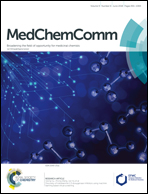Antitumor effects of melanin from Lachnum YM226 and its derivative in H22 tumor-bearing mice†
Abstract
In the present study, we investigated the anti-tumor activities of the intracellular homogeneous melanin (LM) of Lachnum YM226 and its derivative (ALM) on liver cancer using murine H22 hepatocarcinoma model. The results showed that LM and ALM (50 and 200 mg kg−1) could effectively inhibit tumor growth of H22 tumour-bearing mice. The body weight, liver, spleen and thymus indices also improved in the LM and ALM treated groups. Moreover, the levels of alanine aminotransferase (ALT), aspartate aminotransaminase (AST), alkaline phosphatase (ALP), creatinine (CRE), blood urea nitrogen (BUN) and uric acid (UA) were lowered. Serum cytokines of interleukin-2 (IL-2), interleukin-6 (IL-6), tumor necrosis factor-α (TNF-α) and interferon-γ (IFN-γ) were increased on LM and ALM administration, while LM and ALM significantly decreased the vascular endothelial growth factor (VEGF) and basic fibroblast growth factor (bFGF) levels. The H&E staining indicated that LM and ALM exhibited antitumor activity in vivo by promoting apoptosis and inhibiting angiogenesis. The anti-tumor effect of ALM was more significant than that of LM for the same dose. In summary, the findings demonstrated that LM and ALM might be promising candidates for the prevention and treatment of HCC.



 Please wait while we load your content...
Please wait while we load your content...